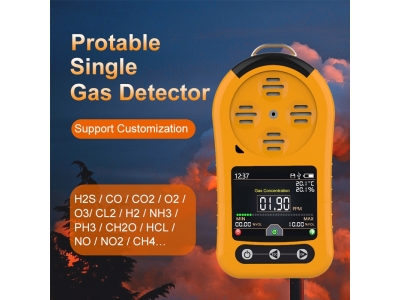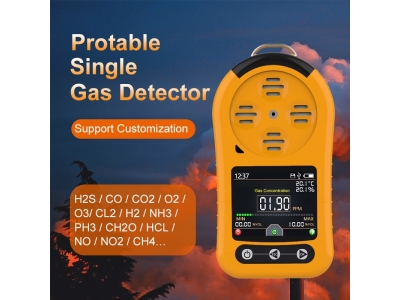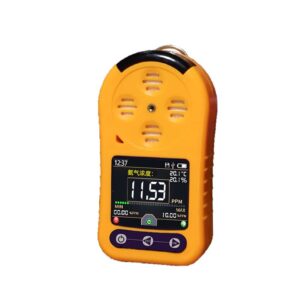
Best Hydrogen Chloride Gas Detector For Industrial Use
Hydrogen chloride gas detector, also known as HCl gas meter, is mainly used to detect and monitor the concentration of hydrogen chloride (HCl) gas in the air.

Hydrogen chloride gas detector, also known as HCl gas meter, is mainly used to detect and monitor the concentration of hydrogen chloride (HCl) gas in the air.
Hydrogen chloride gas detector, also known as HCl gas meter, is mainly used to detect and monitor the concentration of hydrogen chloride (HCl) gas in the air. These gas detection instruments are used for personal protection in the presence of toxic gases. Hydrogen chloride is used in cleaning, pickling, electroplating, tanning, refining and many chemical processes. In addition, HCl is used in the treatment of oil and gas Wells.

Small and low cost HCl gas detectors helps with worker safety.
HCl gas detectors are inexpensive and cost effective.
Excellent tool for protection or aiming for correct purity target level.
A hydrogen chloride (HCl) gas detector is an instrument used to detect the concentration of HCl in the air or in a toxic environment. These devices (specifically the Forensics Detectors FD-90A-HCl) have a long-life battery, clear screen that displays the HCl concentration in ppm, and a belt clip to connect to clothing or a bag. In order to protect users, these gas detectors also have LED, vibration, and buzzer alarms to warn in dangerous situations.
Hydrogen chloride gas detectors are also known as HCl monitors, hydrogen chloride meters, hydrogen chloride analyzers, and HCl gas detectors. These names all refer to the same device, an HCl gas meter.
A hydrogen chloride gas detector senses HCl gas and displays the levels in parts per million (ppm).
The growth of hydrogen chloride detectors has increased due to higher use of HCl in the fuel and steel industries. The harmful effects of HCl on human health and the environment warrant the use of HCl gas detectors to ensure inhalation safety when using this gas.
Hydrogen chloride has the chemical symbol HCl. This gas is colorless or slightly yellow with a pungent smell. HCl is a very useful but dangerous gas. Due to is useful uses, it is employed in various situations, yet requires monitoring to protect humans from inhalation.
When liquified, hydrogen chloride is known as anhydrous hydrochloric acid, hydrochloric acid, hydrochloride, spirits of salt, or muriatic acid.
Yes it is.
When exposed to hydrogen chloride gas, you may experience coughing, pain, inflammation, eye irritation, respiratory illness, and even death. Avoiding hydrogen chloride exposure is essential to avoid occupational hazards.
When inhaled, the dissolution of HCl gas in lung water can produce hydrochloric acid. This reaction leads to pulmonary toxicity, respiratory distress, and other issues.
Yes it is.
Hydrogen chloride gas released into the outdoor environment will be incorporated into clouds and rainfall. The United States EPA enforces HCl emissions through the Clean Air Act. In 2021, the agency identified emission violations at metal recycling facilities. Using HCl monitoring systems, these companies can confirm that their emissions do not exceed predefined thresholds.
If you suspect that you have been exposed to hydrogen chloride gas, it is important to evacuate to an outdoor environment with no traces of HCl exposure. Seek medical attention immediately. Medical professionals can help manage symptoms such as reduced respiratory or heart function.
Preventing exposure is important for safety and can be achieved with an HCl gas detector.
Yes, humans can smell hydrogen chloride gas. It is described to have a pungent and irritating odor.
The hydrogen chloride odor threshold is between 0.3 and 0.8 ppm. See here.

The majority of hydrogen chloride gas detectors are portable. These are small, battery-powered units with a hydrogen chloride sensor that can be clipped onto your clothes for personal protection. They typically come in two different versions. Diffusive models allow the HCl gas molecules to naturally diffuse to the gas sensor head. On the other hand, pump-based detectors include an internal or external micro-pump that moves air over the sensor head. These devices sometimes incorporate probes for point sampling uses.

Wall-mounted units provide continuous protection and warning of hydrogen chloride gas leaks. These devices are perfect for indoor uses. If the levels pass the preset threshold (i.e., 5 ppm OSHA TWA), the unit will provide an LED and buzzer warning.